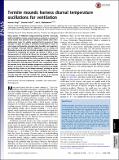Termite mounds harness diurnal temperature oscillations for ventilation
Author(s)
King, Hunter; Ocko, Samuel Alan; Mahadevan, L.
DownloadKing-2015-Termite mounds harne.pdf (1.211Mb)
PUBLISHER_POLICY
Publisher Policy
Article is made available in accordance with the publisher's policy and may be subject to US copyright law. Please refer to the publisher's site for terms of use.
Terms of use
Metadata
Show full item recordAbstract
Many species of millimetric fungus-harvesting termites collectively build uninhabited, massive mound structures enclosing a network of broad tunnels that protrude from the ground meters above their subterranean nests. It is widely accepted that the purpose of these mounds is to give the colony a controlled microclimate in which to raise fungus and brood by managing heat, humidity, and respiratory gas exchange. Although different hypotheses such as steady and fluctuating external wind and internal metabolic heating have been proposed for ventilating the mound, the absence of direct in situ measurement of internal air flows has precluded a definitive mechanism for this critical physiological function. By measuring diurnal variations in flow through the surface conduits of the mounds of the species Odontotermes obesus, we show that a simple combination of geometry, heterogeneous thermal mass, and porosity allows the mounds to use diurnal ambient temperature oscillations for ventilation. In particular, the thin outer flutelike conduits heat up rapidly during the day relative to the deeper chimneys, pushing air up the flutes and down the chimney in a closed convection cell, with the converse situation at night. These cyclic flows in the mound flush out CO[subscript 2] from the nest and ventilate the colony, in an unusual example of deriving useful work from thermal oscillations.
Date issued
2015-09Department
Massachusetts Institute of Technology. Department of PhysicsJournal
Proceedings of the National Academy of Sciences
Publisher
National Academy of Sciences (U.S.)
Citation
King, Hunter, Samuel Ocko, and L. Mahadevan. “Termite Mounds Harness Diurnal Temperature Oscillations for Ventilation.” Proc Natl Acad Sci USA 112, no. 37 (August 27, 2015): 11589–11593.
Version: Final published version
ISSN
0027-8424
1091-6490